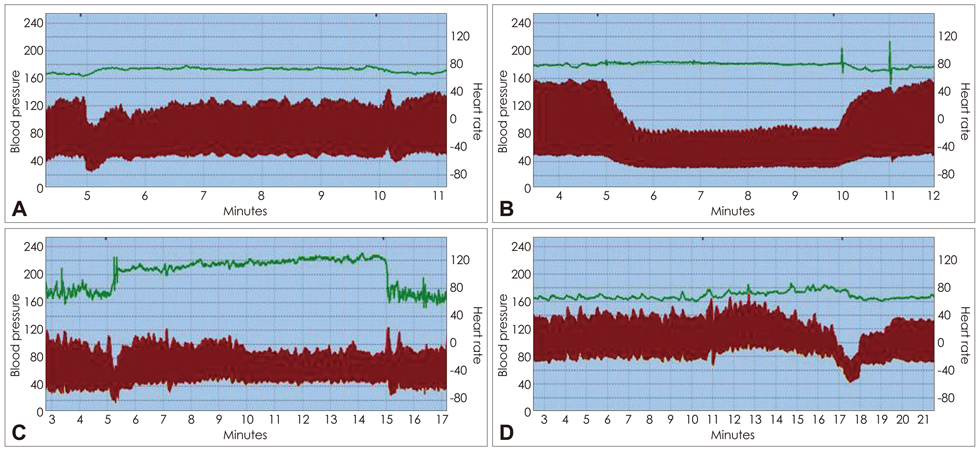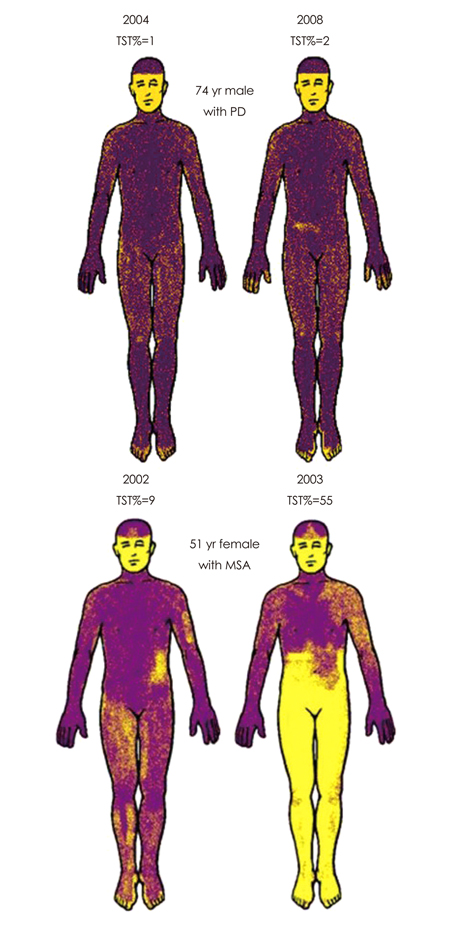Autonomic Function Tests: Some Clinical Applications
- Affiliations
-
- 1Department of Neurology, Mayo Clinic, Rochester, MN, USA. low@mayo.edu
- 2Department of Neurology, Gyeongsang Institute of Health Science, School of Medicine, Gyeongsang National University, Jinju, Korea.
- KMID: 2287563
- DOI: http://doi.org/10.3988/jcn.2013.9.1.1
Abstract
- Modern autonomic function tests can non-invasively evaluate the severity and distribution of autonomic failure. They have sufficient sensitivity to detect even subclinical dysautonomia. Standard laboratory testing evaluates cardiovagal, sudomotor and adrenergic autonomic functions. Cardiovagal function is typically evaluated by testing heart rate response to deep breathing at a defined rate and to the Valsalva maneuver. Sudomotor function can be evaluated with the quantitative sudomotor axon reflex test and the thermoregulatory sweat test. Adrenergic function is evaluated by the blood pressure and heart rate responses to the Valsalva maneuver and to head-up tilt. Tests are useful in defining the presence of autonomic failure, their natural history, and response to treatment. They can also define patterns of dysautonomia that are useful in helping the clinician diagnose certain autonomic conditions. For example, the tests are useful in the diagnosis of the autonomic neuropathies and distal small fiber neuropathy. The autonomic neuropathies (such as those due to diabetes or amyloidosis) are characterized by severe generalized autonomic failure. Distal small fiber neuropathy is characterized by an absence of autonomic failure except for distal sudomotor failure. Selective autonomic failure (which only one system is affected) can be diagnosed by autonomic testing. An example is chronic idiopathic anhidrosis, where only sudomotor function is affected. Among the synucleinopathies, autonomic function tests can distinguish Parkinson's disease (PD) from multiple system atrophy (MSA). There is a gradation of autonomic failure. PD is characterized by mild autonomic failure and a length-dependent pattern of sudomotor involvement. MSA and pure autonomic failure have severe generalized autonomic failure while DLB is intermediate.
Keyword
MeSH Terms
Figure
Cited by 3 articles
-
Reference ranges for autonomic function tests in healthy Korean adults
Kee Hong Park, Byoung Joon Kim, Sa-Yoon Kang, Sun-Young Oh, Eun Hee Sohn, Kyeong-jin Song, Jin-Hong Shin, Kyoung Hwa Kang, Eun Bin Cho, Heejeong Jeong, Hyung Lee, Hyun Ah Kim, Rock Bum Kim, Ki-Jong Park
Ann Clin Neurophysiol. 2017;21(2):87-93. doi: 10.14253/acn.2019.21.2.87.Neurological aspects of anhidrosis: differential diagnoses and diagnostic tools
Kee Hong Park, Ki-Jong Park
Ann Clin Neurophysiol. 2019;21(1):1-6. doi: 10.14253/acn.2019.21.1.1.Spontaneous Conversion of Atrial Fibrillation to Normal Sinus Rhythm Following Recurrent Cerebral Infarctions
Kyungmi Oh, Jeong-Yoon Choi, Byung-Jo Kim
J Korean Neurosurg Soc. 2013;53(6):368-370. doi: 10.3340/jkns.2013.53.6.368.
Reference
-
1. Low PA, Fealey RD, Sheps SG, Su WP, Trautmann JC, Kuntz NL. Chronic idiopathic anhidrosis. Ann Neurol. 1985. 18:344–348.
Article2. Low PA. Autonomic nervous system function. J Clin Neurophysiol. 1993. 10:14–27.
Article3. Low PA, Denq JC, Opfer-Gehrking TL, Dyck PJ, O'Brien PC, Slezak JM. Effect of age and gender on sudomotor and cardiovagal function and blood pressure response to tilt in normal subjects. Muscle Nerve. 1997. 20:1561–1568.
Article4. Low PA, Walsh JC, Huang CY, McLeod JG. The sympathetic nervous system in diabetic neuropathy. A clinical and pathological study. Brain. 1975. 98:341–356.
Article5. Fealey RD, Low PA, Thomas JE. Thermoregulatory sweating abnormalities in diabetes mellitus. Mayo Clin Proc. 1989. 64:617–628.
Article6. Freeman RL. Low PA, Benarroch EE, editors. Noninvasive evaluation of heart rate: time and frequency domains. Clinical Autonomic Disorders. 2008. 3rd ed. Philadelphia: Lippincott Williams & Wilkins;185–197.7. Low PA, Zimmerman BR, Dyck PJ. Comparison of distal sympathetic with vagal function in diabetic neuropathy. Muscle Nerve. 1986. 9:592–596.
Article8. Benarroch EE, Opfer-Gehrking TL, Low PA. Use of the photoplethysmographic technique to analyze the Valsalva maneuver in normal man. Muscle Nerve. 1991. 14:1165–1172.
Article9. Low PA, Singer W. Management of neurogenic orthostatic hypotension: an update. Lancet Neurol. 2008. 7:451–458.
Article10. Schrezenmaier C, Singer W, Swift NM, Sletten D, Tanabe J, Low PA. Adrenergic and vagal baroreflex sensitivity in autonomic failure. Arch Neurol. 2007. 64:381–386.
Article11. Vogel ER, Sandroni P, Low PA. Blood pressure recovery from Valsalva maneuver in patients with autonomic failure. Neurology. 2005. 65:1533–1537.
Article12. Low PA, Sletten DM. Low PA, Benarroch EE, editors. Laboratory evaluation of autonomic failure. Clinical Autonomic Disorders. 2008. 3rd ed. Philadelphia: Lippincott Williams & Wilkins;130–163.13. Goldstein DS, Polinsky RJ, Garty M, Robertson D, Brown RT, Biaggioni I, et al. Patterns of plasma levels of catechols in neurogenic orthostatic hypotension. Ann Neurol. 1989. 26:558–563.
Article14. Kimpinski K, Iodice V, Burton DD, Camilleri M, Mullan BP, Lipp A, et al. The role of autonomic testing in the differentiation of Parkinson's disease from multiple system atrophy. J Neurol Sci. 2012. 317:92–96.
Article15. Singer W, Spies JM, McArthur J, Low J, Griffin JW, Nickander KK, et al. Prospective evaluation of somatic and autonomic small fibers in selected autonomic neuropathies. Neurology. 2004. 62:612–618.
Article16. Low PA. Autonomic neuropathies. Curr Opin Neurol. 2002. 15:605–609.
Article17. Wang AK, Fealey RD, Gehrking TL, Low PA. Patterns of neuropathy and autonomic failure in patients with amyloidosis. Mayo Clin Proc. 2008. 83:1226–1230.
Article18. Klein CM, Vernino S, Lennon VA, Sandroni P, Fealey RD, Benrud-Larson L, et al. The spectrum of autoimmune autonomic neuropathies. Ann Neurol. 2003. 53:752–758.
Article19. Low PA. Diabetic autonomic neuropathy. Semin Neurol. 1996. 16:143–151.
Article20. Thaisetthawatkul P, Boeve BF, Benarroch EE, Sandroni P, Ferman TJ, Petersen R, et al. Autonomic dysfunction in dementia with Lewy bodies. Neurology. 2004. 62:1804–1809.
Article21. Vernino S, Low PA, Fealey RD, Stewart JD, Farrugia G, Lennon VA. Autoantibodies to ganglionic acetylcholine receptors in autoimmune autonomic neuropathies. N Engl J Med. 2000. 343:847–855.
Article22. Iodice V, Lipp A, Ahlskog JE, Sandroni P, Fealey RD, Parisi JE, et al. Autopsy confirmed multiple system atrophy cases: Mayo experience and role of autonomic function tests. J Neurol Neurosurg Psychiatry. 2012. 83:453–459.
Article23. Lipp A, Sandroni P, Ahlskog JE, Fealey RD, Kimpinski K, Iodice V, et al. Prospective differentiation of multiple system atrophy from Parkinson disease, with and without autonomic failure. Arch Neurol. 2009. 66:742–750.
Article24. Thieben MJ, Sandroni P, Sletten DM, Benrud-Larson LM, Fealey RD, Vernino S, et al. Postural orthostatic tachycardia syndrome: the Mayo clinic experience. Mayo Clin Proc. 2007. 82:308–313.
Article25. Shen WK, Low PA, Rea RF, Lohse CM, Hodge DO, Hammill SC. Distinct hemodynamic profiles in patients with vasovagal syncope: a heterogeneous population. J Am Coll Cardiol. 2000. 35:1470–1477.
Article26. The Consensus Committee of the American Autonomic Society and the American Academy of Neurology. Consensus statement on the definition of orthostatic hypotension, pure autonomic failure, and multiple system atrophy. Neurology. 1996. 46:1470.27. Schrezenmaier C, Gehrking JA, Hines SM, Low PA, Benrud-Larson LM, Sandroni P. Evaluation of orthostatic hypotension: relationship of a new self-report instrument to laboratory-based measures. Mayo Clin Proc. 2005. 80:330–334.
Article28. Gilman S, Low PA, Quinn N, Albanese A, Ben-Shlomo Y, Fowler CJ, et al. Consensus statement on the diagnosis of multiple system atrophy. J Neurol Sci. 1999. 163:94–98.
Article29. Schondorf R, Low PA. Idiopathic postural orthostatic tachycardia syndrome: an attenuated form of acute pandysautonomia? Neurology. 1993. 43:132–137.
Article30. Stewart JD, Low PA, Fealey RD. Distal small fiber neuropathy: results of tests of sweating and autonomic cardiovascular reflexes. Muscle Nerve. 1992. 15:661–665.
Article31. Tobin K, Giuliani MJ, Lacomis D. Comparison of different modalities for detection of small fiber neuropathy. Clin Neurophysiol. 1999. 110:1909–1912.
Article32. Novak V, Freimer ML, Kissel JT, Sahenk Z, Periquet IM, Nash SM, et al. Autonomic impairment in painful neuropathy. Neurology. 2001. 56:861–868.
Article33. Low VA, Sandroni P, Fealey RD, Low PA. Detection of small-fiber neuropathy by sudomotor testing. Muscle Nerve. 2006. 34:57–61.
Article
- Full Text Links
- Actions
-
Cited
- CITED
-
- Close
- Share
- Similar articles
-
- Autonomic dysfunction in patients with orthostatic dizziness
- Autonomic Nerve Function Tests in Patients with Diabetes
- Interpretation of Autonomic Function Test
- Autonomic Nervous Dysfunction in Patients with Rheumatoid Arthritis
- The Subjective and Objective Evaluations of Autonomic Nervous System Function in Stroke Patients




